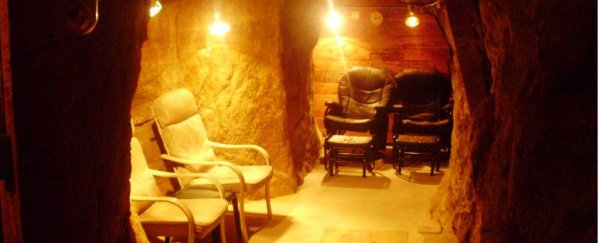Every year, people from all over the United States - and even overseas - travel to the Boulder-Basin in Montana for a potentially dangerous alternative treatment.
They sit in the tunnels of a handful of 'radon health mines' – which are decommissioned gold and uranium mines - breathing in air tainted with radon, and even drinking radon water.
Those that go to the mines are there to treat a number of chronic pain conditions, including arthritis, back injuries and fibromyalgia.
And yes, this is the same radioactive chemical element that the United States Environmental Protection Agency (EPA) warns about - high concentrations of radon are clearly linked to an increased risk of lung cancer.
According to epidemiologist Tim Driscoll from the University of Sydney and the Occupational and Environmental Cancer Committee at the Cancer Council, radon is not to be messed with.
"If the radon's breathed in, it's in the lung – either in the airways or lodged in the tissue," explains Driscoll in an interview with ScienceAlert.
"When it breaks down, alpha particles cause direct damage to the DNA of the lung cells, and increase your risk of cancer."
In normal situations, there are a few reasons why we sometimes need to be exposed to radiation for medical purposes. Every time you get an X-ray you get a short blast of radiation, and if you have to have radiotherapy for cancer, you'll get a decently sized dose.
But these are specially monitored circumstances, with many precautions in place as to the dose, purpose and duration of treatment.
A 2003 report by the EPA estimates that approximately 20,000 Americans die of radon-related lung cancer each year just from the radon build up in basements and in their homes. (According to Driscoll, this is less of an issue in Australia and some other parts of the world.)
In the report, it is urged that Americans test their homes – according to the EPA, WHO and CDC, any amount of radon higher than 4 picocuries per litre (pCi/L) can be dangerous.
A picocurie is a measure of the rate of radioactive decay of an element – the higher the curie, the more radons currently decaying into alpha particles in the air you're breathing.
We know that radon is so dangerous to breathe in partly because of mine workers. Lung cancer deaths were at a much higher rate amongst uranium or other hard rock mine workers than average in the 40's and 50's – even when controlling for smoking or other variables.
In one study from the 80's, mine workers who didn't smoke were nearly 13 times more likely to get lung cancer than the control group.
Entering a radon mine can give you a blast of 1,700 pCi/L of air on average – a pretty amazing leap over the 4 pCi/L that's recommended.
Knowing this information, it's hard to imagine why anyone would go out and intentionally breathe in large amounts of radon, but for the travellers that go to these health mines, it's not quite that black and white.
The visitors of these mines really believe they see a tangible benefit from sitting in an irradiated mine for up to 60 hours over 10 days.
Plus, according to a small number of reputable scientific research papers - at least in the case of rheumatoid arthritis - radon therapy appears to work better than a placebo.
However, it's really important to note that the studies can't tell us how it worked, and the scientific basis for radon's efficacy is pretty thin on the ground.
"I'm pretty sceptical that radon would be able to relieve pain," says Driscoll.
But even if it did, "in the vast majority of cases I think there would be other ways to treat the pain that wouldn't come with the same risks that the exposure to the radon would carry."
These studies have been carried out in Europe, where radon spa therapies are more common. This includes a number of radon spa treatment spots in Ukraine and a handful in Germany that have been going for a century.
Remarkably, whether you drink water laced with radon, sit in a bath of the stuff, or inhale it directly, the element's effect on the body will actually be similar.
"Within a couple of minutes, half the radon in the water will diffuse into the air," Bill Field, a radon expert from the University of Iowa, explained to GlobalPost back in 2016.
"Once the gas diffuses out, it creates the decay products that cause the majority of the lung cancers. I wouldn't want to be in a room where there are 25 to 35 nanocuries per litre of radon."
(1 nanocurie is 1,000 picouries, so you'd be looking at slightly more than in the American radon mines.)
People from all walks of life do this – Amish and Mennonites are frequent customers due to its 'natural' appeal.
And despite the dangers of this practice, it's unlikely to go away any time soon.
But there might be an upside – the average age of these visitors is over 70.
"It could be 10 or 20 years before any cancer related to the radon could become manifest," says Driscoll.
"If you had really excruciating chronic pain, and you had a treatment that would relieve that, and you're 80 years old, then radon is unlikely to be a problem with causing you cancer."
But in general, he advises to stay well clear.
"I would not be advocating anyone go out looking for it. There's no doubt that exposure to radon increases the risk of cancer."
